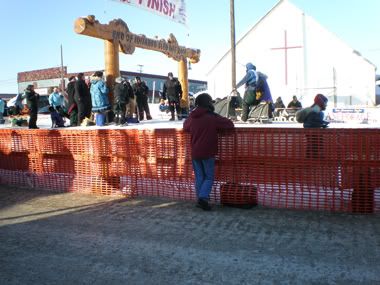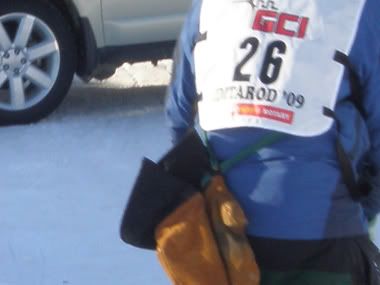
Written by Nancy Duresky
Wednesday, March 20, 2009
Tonight the first rookie came into Nome. It is a great father – son story. Sonny Linder, the father of the pair, is a great musher. He moved to Fairbanks in 1970 and begun mushing. He started running the Iditaod in 1976. A few years later, he won the first Yukon Quest, another 1,000+ mile annual sled-dog race that runs from Alaska to Canada. He has three grown children and three younger children. In 2009, he was the eleventh musher into Nome.
One of his sons, Chad, graduated from law school and took a year off before he started his career. He came back to Alaska just to run the Iditarod with his father. And he not only finished the race, but also was the first rookie into Nome. What a wonderful young man to give such a great gift to his father. And how proud his father must be of all of Chad’s accomplishments. At the finish line, Chad said this would be the only time he runs the race. Most probably that is true, however, I’m not going to hold him to that statement. He’s welcome back anytime.
At the Banquet Sunday night, one of the rookie mushers will receive the “Rookie of the Year” award. It is for a first time finisher who showed the best sportsmanship, the best dog care and the best mushing expertise during the race. Dog care is a big deal on the trail. The veterinarians give an award for the musher who gave his dog the best care during the race. When mushers come into a checkpoint to stay, or take a rest on the trail, they cannot simply take a nap themselves. They are the only one who can care for their dogs. It is true that a vet checks the health of the dogs at the checkpoint, however, the musher must carry water or melt snow to give the dogs water, give them a snack, put down straw for each dog to sleep on, check the dogs’ feet (in a team of 16 dogs, that is 64 paws to check) and rub salve into their paws, cook for the dogs and feed them, eat something, re-rub salve into their paws, feed them once again before they leave, pack up the sled, check their harnesses, re-bootie the dogs and sign out to leave. That is just a partial list. Mushers become sleep deprived as the race wears on. Many mushers write about seeing hallucinations on the trail. Some fall asleep on the sled.
There are two types of sleds in use now. When I first started following the Iditarod, there was only the traditional sled with two runners extending behind the basket. Mushers would stand on the runners, sometime pump (stand on one runner and push with the other foot as if he or she were standing on a skate board), and going up hill, she or he would jump off and push the sled uphill to help the dogs. Then he would jump back on and pump and pole – use a ski pole to push the sled along. When riding on the runners, it was not a passive activity. A few days into the race, a sleep-deprived musher would fall asleep standing up and fall off of his or her sled. The dogs would take off. The musher was alone in the bush and had no choice but to follow the dogs on foot until they stopped and he could catch up.
Then, a few years ago, Jeff King developed a sled that comes in two parts. First comes a smaller version of the main basket, then the runners, and then ‘the caboose.’ A musher can still stand on the runners and pump and pole. However, the real advantage of the sled is that the musher can sit down on the caboose and snooze for a few minutes while the dogs carry on. At one of the red lantern banquets, a young musher called it “the old man’s sled.” In spite of that name, more and more mushers are switching over to the two-basket model. In fact, Chad used the two basket model in this race.
One final thought: the Linders are not the only father-son pair in this race. The Seaveys have a combination I have never before seen – running this race is Mitch, who finished 4th and is the father of Dallas. Dallas completed this race in 6th position. Also in this race is Mitch’s daughter-in-law, Dallas’ wife, Jen Seavey, who at this point is still on the trail. She is in position 47 and has left the Shaktoolik checkpoint. At age 18, she came to Alaska to work as a dog handler for the Seavey kennel and ended up marrying Dallas. And she is as cute and tough as she can be.


